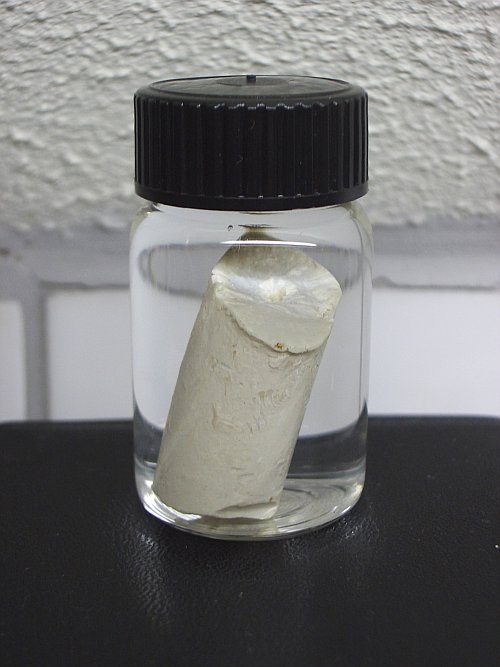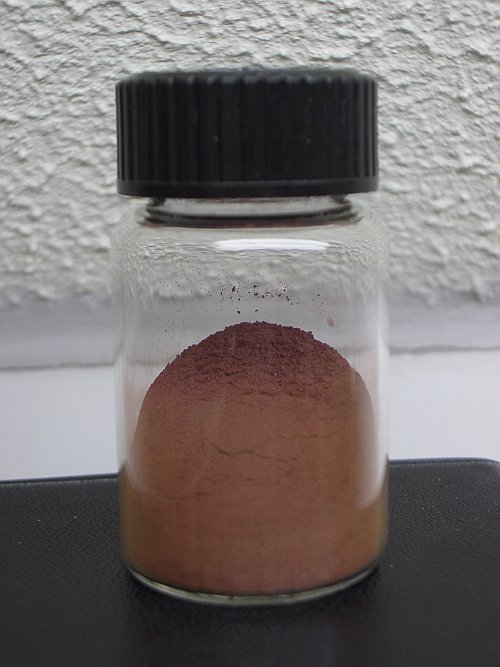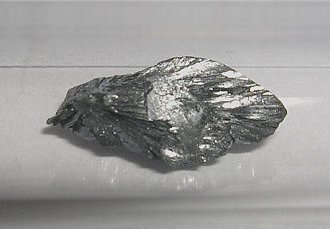


Phosphorus
The element phosphorus exists in three allotropes.


The white allotrope consists of molecules P4 and is a low-melting, very reactive and very poisonous compound. The heat of a hand can be sufficient to ignite white phosphorus. The red allotrope is a red/brown compound, which is quite inert. There are no solvents, in which this compound dissolves. Red phosphorous is non-toxic. Because of its relative inertness, and the inability to produce solutions of red phosphorus, there is no interesting solution-chemistry. At higher temperatures, red phosphorus becomes much more reactive. It can burn easily and when mixed with strong oxidizers, powerful and dangerous pyrotechnic mixtures can be produced.
 The black allotrope is the most inert allotrope of
phosphorus. It is quite unreactive and has limited practical applications. As
for red phosphorus, no solvent exists for the black allotrope. The picture at
the left shows a small sample of black phosphorus, as it sometimes is offered on
eBay by element sellers.
The black allotrope is the most inert allotrope of
phosphorus. It is quite unreactive and has limited practical applications. As
for red phosphorus, no solvent exists for the black allotrope. The picture at
the left shows a small sample of black phosphorus, as it sometimes is offered on
eBay by element sellers.
Elementary phosphorus is of limited interest for the home lab. The white allotrope simply is too dangerous for the home lab, the red allotrope only is interesting in dry-chemical experiments, the black allotrope is too expensive for the average home lab. Some dry-chemical experiments with red phosphorous, however, are quite interesting, and a few of them are given on this website.
Unfortunately, phosphorus is one of the elements, which is banned in many countries, due to recent misuse of the element in the manufacture of synthetic drugs. The red allotrope can be ordered at some chemical supply houses, geared towards pyrotechnics. The black allotrope sometimes is available on eBay from element collectors items suppliers, but at a fairly high price.
![]()
The following compounds of phosphorus are available for the public:
- trisodium phosphate anhydrous or hydrated, Na3PO4 or Na3PO4·12H2O
- disodium phosphate, Na2HPO4·7H2O
- monosodium phosphate, NaH2PO4·2H2O
- phosphoric acid, H3PO4
- calgon, also known as sodium "hexametaphosphate", Nan(PO3)n
- calcium phosphate, Ca3(PO4)2
![]() Chemically speaking, the first four compounds all are similar, with the most
important changing parameter the pH of the solution of the compound in water.
The first three phosphates are white solids. Phosphoric acid also is a white
solid, but usually it is sold in the form a viscous colorless liquid, with
approximately 85% acid by weight. Solutions of trisodium phosphate are
moderately strongly alkaline. Solutions of disodium phosphate are slightly
alkaline. Solutions of monosodium phosphate are slightly acidic and a solution
of phosphoric acid is moderately strongly acidic. Phosphate is quite inert in
terms of redox chemistry. Only in the presence of a strong reductor as zinc
metal, phosphate ion is reduced. From the point of view of coordination
chemistry, phosphate is more interesting. Phosphate forms complexes with many
transition metals, most notably with iron, with which is forms a colorless
complex. In this way, it can hide the presence of iron in a solution completely.
Chemically speaking, the first four compounds all are similar, with the most
important changing parameter the pH of the solution of the compound in water.
The first three phosphates are white solids. Phosphoric acid also is a white
solid, but usually it is sold in the form a viscous colorless liquid, with
approximately 85% acid by weight. Solutions of trisodium phosphate are
moderately strongly alkaline. Solutions of disodium phosphate are slightly
alkaline. Solutions of monosodium phosphate are slightly acidic and a solution
of phosphoric acid is moderately strongly acidic. Phosphate is quite inert in
terms of redox chemistry. Only in the presence of a strong reductor as zinc
metal, phosphate ion is reduced. From the point of view of coordination
chemistry, phosphate is more interesting. Phosphate forms complexes with many
transition metals, most notably with iron, with which is forms a colorless
complex. In this way, it can hide the presence of iron in a solution completely.
The sodium salts can be ordered at photography raw chemical suppliers, phosphoric acid sometimes can be obtained locally at a better equipped drugstore. Shipping concentrated phosphoric acid is not a real option, due to shipping regulations. Concentrated phosphoric acid is corrosive.
From the point of view of the home chemist, phosphates can be interesting for coordination chemistry experiments. Phosphoric acid is useful as a non-oxidizing and non-reductive acid.
![]() Calgon is a white solid. It consists of a polymeric species, with PO3–
units attached to each other in long chains. Calgon is used for coordinating
earth alkali metal ions, such that they are not available anymore for other
reactions. When one has very hard water, then adding a pinch of calgon to the
water may reduce the interfering effect of calcium and magnesium ions. Sometimes
this may be beneficial, provided that the calgon itself has no adverse effect on
the experimental outcome.
Calgon is a white solid. It consists of a polymeric species, with PO3–
units attached to each other in long chains. Calgon is used for coordinating
earth alkali metal ions, such that they are not available anymore for other
reactions. When one has very hard water, then adding a pinch of calgon to the
water may reduce the interfering effect of calcium and magnesium ions. Sometimes
this may be beneficial, provided that the calgon itself has no adverse effect on
the experimental outcome.
Calgon does not add much to a home lab. It can be obtained at many drugstores and can be ordered at photography raw chemical suppliers.
![]() Calcium phosphate is a white or light grey solid. It does not dissolve in water,
but it easily dissolves in an acidic liquid, forming free calcium ions and
phosphoric acid.
Calcium phosphate is a white or light grey solid. It does not dissolve in water,
but it easily dissolves in an acidic liquid, forming free calcium ions and
phosphoric acid.
Calcium phosphate can be purchased at drugstores. However, it is not a very interesting compound. For the home chemist, the sodium salts are more interesting, because these allow experimenting with phosphate over the entire pH range, while calcium phosphate only allows experimenting with phosphate at low pH. At higher pH the solid again precipitates from solution as a white solid.